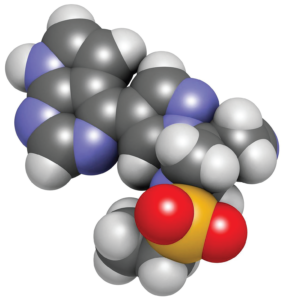 EULAR 2022 (VIRTUAL)—It’s been 10 years since the first Janus kinase (JAK) inhibitor was approved for the treatment of rheumatoid arthritis (RA) in the U.S., with several others following suit. Hopes were high for JAK inhibitors to revolutionize RA care. So were all promises fulfilled?
EULAR 2022 (VIRTUAL)—It’s been 10 years since the first Janus kinase (JAK) inhibitor was approved for the treatment of rheumatoid arthritis (RA) in the U.S., with several others following suit. Hopes were high for JAK inhibitors to revolutionize RA care. So were all promises fulfilled?
At the 2022 Congress of the European Alliance of Associations for Rheumatology (EULAR), Hendrik Schulze-Koops, MD, PhD, professor, Division of Rheumatology and Clinical Immunology, Ludwig-Maximilians University Munich, Germany, reviewed the data available to answer this question. He focused on JAK inhibitors as a class, as opposed to specific drugs.
JAK Inhibitor Promises
Dr. Schulze-Koops first delineated promises of JAK inhibitor therapies with help from an ACR Convergence 2021 abstract.1 Taylor et al. conducted surveys to understand why physicians chose JAK inhibitors for certain patients. The most important clinical reason for a physician to prescribe a JAK inhibitor was the hope for strong overall efficacy. This was followed by a desire for a fast onset of action, inhibition of disease progression, strong efficacy as monotherapy and achievement of clinical remission.
Consequently, Dr. Schulze-Koops organized his talk by four JAK inhibitor promises: 1) efficacy; 2) drug survival; 3) safety; and 4) simple mechanism of action.
Promise 1: Efficacy
“Some years ago, it was very apparent that whatever we did with biologics, we had similar ACR20, ACR50, and ACR70 responses across the available biologic disease-modifying anti-rheumatic drugs (bDMARDs). Whether it was tumor necrosis factor-α (TNFα) inhibitors or a non-TNFα inhibitor, we were seeing about a 60–70% ACR20, 30% ACR50 and 20% ACR70 response rates. This is what the JAK inhibitors had to compete with,” Dr. Schulze-Koops explained.2
In 2012, we saw data showing an ACR20 response rate of 59.8% at month three for a JAK inhibitor as monotherapy.3 A year later, we saw data speaking to the efficacy of a JAK inhibitor in combination with methotrexate in patients with moderate-to-severe RA who had failed to respond to TNFα inhibitors. The ACR20 response rate was 41.7% at month three, with a small percentage of patients even achieving Disease Activity Score-28 (DAS28) remission.4
In 2017, a year-long study demonstrated that a JAK inhibitor in combination with methotrexate worked quickly and better than a TNFα inhibitor, with an increased ACR20 response rate at month three with the JAK inhibitor vs. adalimumab (70% vs. 61%, P=0.014). Responses were maintained for at least a year.5
However, Dr. Schulze-Koops noted that “only about 15% of patients reached the treatment goal that we have given ourselves for RA [low disease activity or remission] in these trials.”3,5
“I would say that in RA, JAK inhibitors are at least as effective as other bDMARDs in terms of clinical response in methotrexate and TNFα inhibitor non-responder populations,” he concluded. “The promise that they’re as good as bDMARDs is fulfilled, but a promise beyond that—100% remission—is not fulfilled.”
Promise 2: Drug Survival
Dr. Schulze-Koops next addressed JAK inhibitor drug survival (i.e., the length of time until discontinuation of drug). Drug survival considers discontinuation for all reasons e.g., tolerability, side effects, safety, effectiveness). “The half-life of TNFα inhibitor therapy is about two years because these drugs lose their effect and patients become secondary non-responders,” he said. “On the other hand, the half-life of JAK inhibitors is close to five years. So I would say that promise no. 2 is fulfilled.”6,7
Promise 3: Safety
Since JAK inhibitor development, numerous attempts have been made to document the safety of JAK inhibitors for patients, and an enormous amount of data exist from which to deduce safety statements. Studies have pooled data from phase 1, 2, 3 and 3B/4 randomized controlled trials (RCTs) and open-label, long-term extension studies.
Initial long-term safety data indicated that safety profiles were generally comparable between JAK inhibitors and bDMARDs. “Tofacitinib and baricitinib fell almost in the middle when it came to problems we detect with bDMARDs, with the exception of [an increased rate] of the incidence of herpes zoster,” Dr. Schulze-Koops remarked.8,9
Regarding major adverse cardiovascular events (MACE), a 2019 systematic review and meta-analysis of 26 RCTs didn’t demonstrate an increased risk of MACE with JAK inhibitors over placebo.10 Recent observational data from RABBIT, the German register for the long-term observation of therapy with biologics in adult patients with RA, also didn’t demonstrate an increased incidence rate of MACE compared with TNFα inhibitors or conventional synthetic DMARDs.11 This held true for a higher risk group of patients aged 50 and above with one or more cardiovascular risk factors.
The most important clinical reason for a physician to prescribe a JAK inhibitor was the hope for strong overall efficacy.
Finally, a 2020 systematic review and meta-analysis of 82 studies comprising 66,159 patients with immune-mediated diseases (inflammatory bowel disease, RA, psoriatic arthritis and ankylosing spondylitis) didn’t demonstrate an increased risk of malignancy or MACE, either.12
“Based on these studies, the JAK inhibitors have a benign safety profile that wouldn’t put our patients at a particular risk—except for herpes zoster, which we can manage these days by vaccination,” Dr. Schulze-Koops remarked. However, we all now know about the ORAL surveillance study, which has changed things.”
The ORAL surveillance study was published in the New England Journal of Medicine in January 2022. This was a “randomized, open-label, noninferiority, post-authorization, safety end-point trial involving patients with active RA despite methotrexate treatment who were 50 years of age or older and had at least one additional cardiovascular risk factor.”13
Dr. Schulze-Koops explained, “The ORAL investigators intentionally looked at an ‘at-risk population.’ And all of a sudden it appeared there was an increased risk of MACE and malignancy compared with TNFα inhibitors.”
Shortly after the publication of ORAL, another study (STAR-RA) showed similar results.14 STAR-RA looked at two cohorts of RA patients initiating therapy with tofacitinib or a TNFα inhibitors: “a real-world evidence cohort consisting of routine care patients, and an RCT-duplicate cohort mimicking inclusion and exclusion criteria from the ORAL surveillance trial to calibrate results against the trial findings.”
“The real-world experience cohort had no increased risk for cardiovascular outcomes,” explained Dr. Schulze-Koops, “similar to our RABBIT register data.” However, tofacitinib was associated with an increased risk of cardiovascular outcomes, although not statistically significant, in patients with RA with cardiovascular risk factors. “There appears to only be a difference in risk in the ‘at-risk’ group, just like ORAL,” he said.
Data from ORAL induced medical warnings for different JAK inhibitors across the world.15,16 So are they safe and should we prescribe them for our patients or not? “Because of safety concerns, only use a JAK inhibitor if you explicitly consider the potential side effects for every patient,” said Dr. Schulze-Koops. “In at-risk populations, I think we should wait until we have conclusive evidence as to why these increased risks happen before we close the book.
Promise 4: Simple Mechanism of Action
On a biochemical level, what do JAK inhibitors do? A kinase is an enzyme that transfers a phosphate residue to a substrate, and JAK inhibitors prevent this from occurring. However, the human body has 518 protein kinases. “In essence, the mechanism of action of JAK inhibitors is simple,” said Dr. Schulze-Koops. “But if we try to inhibit just one kinase, we must accept that this will never be 100% selective or specific in any given life situation. We need to learn more to understand how exactly JAK inhibitors work, and how they put particular patient populations at particular risk.”
In Sum
Dr. Schulze-Koops concluded his talk on a positive note. “Overall, I think that JAK inhibitors are wonderful and a perfect addition to our treatment armamentarium. However, there may be something [about JAK inhibitors] that’s as dark as this room is without the lights on, and I’m looking forward to seeing that data. Only then will we be able to determine if all JAK inhibitor promises have been fulfilled.”
Samantha C. Shapiro, MD, is an academic rheumatologist and an affiliate faculty member of the Dell Medical School at the University of Texas at Austin. She is also a member of the ACR Insurance Subcommittee.
References
- Taylor PC, Fautrel B, Piette Y, et al. Physicians’ reasons for prescribing Janus kinase inhibitors (JAKi) in patients with rheumatoid arthritis, and associated alignment between physicians and patients in a real-world clinical setting [abstract]. Arthritis Rheumatol. 2021:73(suppl 10).
- Matsuno H. Treatment of rheumatoid arthritis with biological agents. In: Innovative Rheumatology, ed. Matsuno H. London: IntechOpen. 2013.
- Fleischmann R, Kremer J, Cush J, et al. Placebo-controlled trial of tofacitinib monotherapy in rheumatoid arthritis. N Engl J Med. 2012 Aug 9;367(6):495–507.
- Burmester GR, Blanco R, Charles-Schoeman C, et al. Tofacitinib (CP-690,550) in combination with methotrexate in patients with active rheumatoid arthritis with an inadequate response to tumour necrosis factor inhibitors: A randomised phase 3 trial. Lancet. 2013 Feb 9;381(9865):451–460.
- Taylor PC, Keystone EC, van der Heijde D, et al. Baricitinib versus placebo or adalimumab in rheumatoid arthritis. N Engl J Med. 2017 Feb 16;376(7):652–662.
- Flendrie M, Creemers MCW, Welsing PMJ, et al. Survival during treatment with tumour necrosis factor blocking agents in rheumatoid arthritis. Ann Rheum Dis. 2003 Nov;62(suppl 2):ii30–33.
- Pope J, Keystone E, Jamal S, et al. Persistence of tofacitinib in the treatment of rheumatoid arthritis in open-label, long-term extension studies up to 8 years [abstract]. Arthritis Rheumatol. 2016;68(suppl 10).
- Cohen SB, Tanaka Y, Mariette X, et al. Long-term safety of tofacitinib up to 9.5 years: A comprehensive integrated analysis of the rheumatoid arthritis clinical development programme. RMD Open. 2020 Oct;6(3):e001395.
- Winthrop K, Takeuchi T, Burmester G, et al. Safety profile of baricitinib for the treatment of rheumatoid arthritis up to 8.4 years: An updated integrated safety analysis [abstract]. Arthritis Rheumatol. 2020;72(suppl 10).
- Xie W, Huang Y, Xiao S, et al. Impact of Janus kinase inhibitors on risk of cardiovascular events in patients with rheumatoid arthritis: Systematic review and meta-analysis of randomised controlled trials. Ann Rheum Dis. 2019 Aug;78(8):1048–1054.
- Meissner Y, Albrecht K, Kekow J, et al. Risk of cardiovascular events under Janus kinase inhibitors in patients with rheumatoid arthritis: Observational data from the German RABBIT register. Ann Rheum Dis. 2022;81:86–87.
- Olivera PA, Lasa JS, Bonovas S, et al. Safety of Janus kinase inhibitors in patients with inflammatory bowel diseases or other immune-mediated diseases: A systematic review and meta-analysis. Gastroenterology. 2020 May;158(6):1554–1573.e12.
- Ytterberg SR, Bhatt DL, Mikuls TR, et al. Cardiovascular and cancer risk with tofacitinib in rheumatoid arthritis. N Engl J Med. 2022 Jan;386(4):316–326.
- Khosrow-Khavar F, Kim SC, Lee H, et al. Tofacitinib and risk of cardiovascular outcomes: results from the Safety of TofAcitinib in Routine care patients with Rheumatoid Arthritis (STAR-RA) study. Ann Rheum Dis. 2022 Jun;81(6):798–804.
- Losavio K. FDA requires new boxed warnings on JAK inhibitors, places restrictions on use. The Rheumatologist. 2021 Sep 1.
- Pfizer. XELJANZ safety review recommendation issued in the European Union. 2022 Jun 9.


